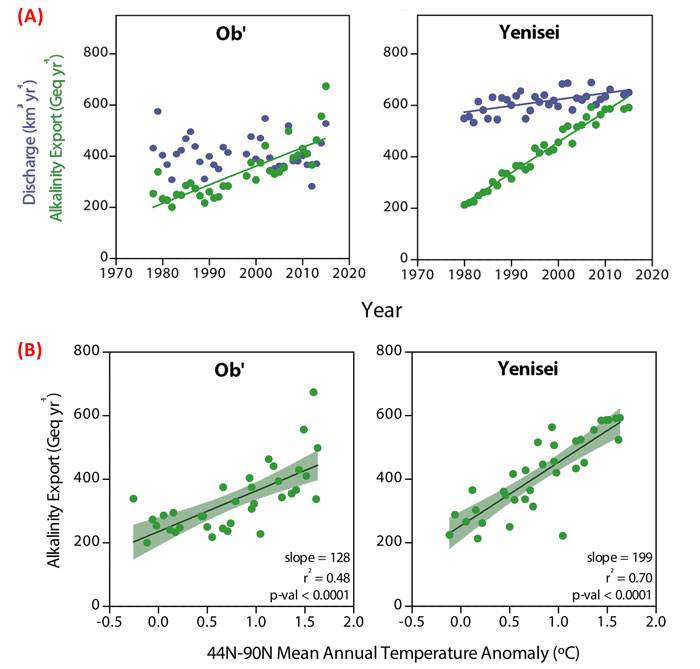| Tweet | Follow @co2science |
Paper Reviewed
Drake, T.W., Tank, S.E., Zhulidov, A.V., Holmes, R.M., Gurtovaya, T. and Spencer, R.G.M. 2018. Increasing alkalinity export from large Russian Arctic rivers. Environmental Science & Technology 52: 8302-8308.
Writing as background for their study, Drake et al. (2018) note that "riverine carbonate alkalinity, in the form of bicarbonate (HCO3-) and carbonate (CO32-) ions, represents an important biogeochemical flux of carbon from land to ocean." In fact, over long time scales, this alkalinity flux "controls the calcium carbonate (CaCO3) saturation state in the ocean and can function as a sink for atmospheric carbon dioxide." Thus, changes in riverine carbonate alkalinity also have important implications for so-called ocean acidification via its potential to enhance or slow down the contemporary decline in oceanic pH caused by rising atmospheric CO2. And recognizing this potential, the team of six scientists set out to examine trends in this important parameter for two of the largest rivers in the Arctic, the Ob' and Yenisei. In terms of annual discharge rates to the Arctic Ocean, the Yenisei and Ob' rivers are the largest and third largest, respectively, and for the globe as a whole they are the fifth and 13th largest, again respectively.
To accomplish their objective, Drake et al. utilized a suite of pertinent data to estimate the total annual alkalinity flux from these two rivers from which they determined trends in alkalinity export from the Ob' and Yenisei into the Arctic Ocean over the period 1974-2015. The results are depicted in the figure below.
As shown in Figure 1a, annual discharge rates at the Ob' River exhibited no long-term trend, whereas they experienced a statistically significant rise of 14.7% at the Yenisei River over the past four decades. And despite the differences in discharge rates, the annual export of alkalinity from both rivers rose dramatically over the period of study, with export from the Ob' and Yenisei increasing by 134% and 185%, respectively.
With respect to the cause of the increase of alkalinity production and export, Figure 1b reveals a strong linear correlation between this parameter and mean annual temperatures in the high northern latitudes (44-90°N). According to the authors, "higher surface air temperatures may have direct and indirect effects on weathering via permafrost thaw, microbial respiration, and the enhanced productivity of surface vegetation." With respect to permafrost thaw, they say that it "exposes unweathered mineral surfaces, increases residence times of infiltrating water, and increases mixing with mineral rich groundwater, all of which promote alkalinity production and export." What is more, they note other reasons that could also be contributing to the enhanced alkalinity export, including (1) biological effects driven by CO2 fertilization that enhances below-ground chemical weathering, (2) declines in acid deposition, (3) increased precipitation, (4) changes in hydrologic flow paths, and (5) shifts in vegetation.
Given the array of overlapping changes in the above-mentioned potential influences of alkalinity export that have occurred in the Arctic over the past 40 years, Drake et al. lament that it is "difficult to assess the importance of any single driver." Nevertheless, they say that "regardless of the direct causes, these trends have broad implications for the rate of carbon sequestration on land and delivery of buffering capacity to freshwater ecosystems and the Arctic Ocean." Consequently, more research should be conducted in this area so as to determine the impact of this enhanced riverine carbonate alkalinity on future projections of ocean acidification in the Arctic and elsewhere. It may be that the buffering capacity of the world's oceans at shorter timescales is greater than anticipated. And that has important implications for a potential slow-down and partial mitigation of predicted ocean acidification impacts.

Figure 1. Panel A: Annual river discharge (blue markers) and alkalinity export (green markers) for the Ob' and Yenisei Rivers over the period 1974-2015. Panel B: Alkalinity export plotted as a function of mean annual temperature anomalies for the Ob' and Tenisei Rivers, with the shaded band indicating the 95% confidence intervals. Source: Adapted from Drake et al. (2018).




